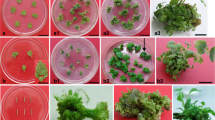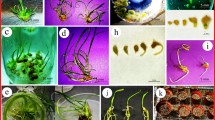Summary
An efficient protocol for in vitro propagation of the valuable medicinal plant, Wasabia japonica (Miq.) Matsumura is described through shoot tip proliferation and direct regeneration. Multiple shoots were induced from shoort tips cultured on Murashige and Skoog (MS) semi-solid medium containing various concentrations (0.5–50 μM) of N6-benzyladenine (BA), thidiazuron, kinetin, and zeatin. A comparison was made on shoot multiplication between semi-solid and liquid culture media. Well-developed shoots were obtained using full-strength MS semi-solid medium containing 5.0 μM BA. However, the greatest shoot proliferation was achieved on either full- or half-strength MS liquid media supplemented with 5.0 μM BA for 4 wk (15.3±0.9 and 15.0±0.7 shoots per explant, respectively), and on half-strength MS liquid medium for 6 wk (25.8±1.3 shoots per explant) in culture. In contrast, the maximum number of shoots per explant on full-strength MS semi-solid medium was achieved with either 5.0 μM BA (10.4±0.6 shoots per explant) or 10.0 μM kinetin (10.9±0.8 shoots per explant). Fresh weight of explants and length of shoots derived from full-strength MS liquid medium (1055±77 mg and 34.2±1.0 mm, respectively) were significantly higher than those derived from full-strength MS semisolid medium (437.6±17.3 mg and 15.4±0.7 mm, respectively). Quarter-strength MS liquid medium had no significant difference in shoot proliferation when compared to quarter-strength MS semi-solid medium. Elongated shoots were separated and rooted on half-strength MS semi-solid media fortified with 1-naphthaleneacetic acid (NAA), indole-3-butyric acid (IBA), or indole-3-acetic acid (IAA) ranging from 0.1 to 10.0 μM. Root formation was greatest with IBA when compared with IAA and NAA. One hundred percent of shoots were rooted on half-strength MS medium with 5.0 μM IBA, while vigorous roots were obtained with 10.0 μM IBA. Micropropagated plantlets were successfully established in soil with 95% survival rate after heardening.
Similar content being viewed by others
References
Arikat, N. A.; Jawad, F. M.; Karam, N. S.; Shibli, R. A. Micropropagation and accumulation of essential oils in wild sage (Salvia fruticosa Mill.). Sci. Hort. 100:193–202; 2004.
Bermúdez, P. P.; Seitz, H. U.; Gavidia, I. A protocol for rapid micropropagation of endangered Isoplexis. In Vitro Cell. Dev. Biol. Plant 38:178–182; 2002.
Borthakur, M.; Singh, R. S. Direct plantlet regeneration from male inflorescences of medicinal yam (Dioscorea floribunda Mart. & Gal.). In Vitro Cell Dev. Biol. Plant 38:183–185; 2002.
Chadwick, C. I. Wasabi. Wasabia japonica (Miq.) Matsum., a semi-aquatic crop from Japan. MS Thesis. Washington State University, Pullman, WA; 1990; 15–25.
Chadwick, C. I.; Lumpkin, T. A.; Elberson, L. R. The botany, uses and production of Wasabia japonica (Miq.) (Cruciferae) Matsumura. Econ. Bot. 47:113–135; 1993.
Depree, J. A.; Howard, T. M.; Savage, G. P. Flavour and pharmaceutical properties of the volatile sulphur compounds of wasabi (Wasabia japonica). Food Res. Int. 31:329–337; 1999.
Dorsch, W.; Adam, O.; Weber, J.; Ziegeltrum, T. Antiasthmatic effects of onion extracts—Detection of benzyl, and other isothiocyanates (mustard oil) as antiasthmatic compounds of plant origin. Eur. J. Pharmacol. 107:17–24; 1985.
Etoh, H.; Nishimura, A.; Takasawa, R.; Yaki, A.; Saito, K.; Sakata, K.; Kishima, I.; Ina, K.. ω-Methylsulfinylalkyl isothiocyanates in wasabi, Wasabia japonica Matsum. Agric. Biol. Chem. Tokyo 54:1587–1589; 1990.
Fuke, Y.; Ohishi, Y.; Iwashita, K.; Ono, H.; Shinohara, K. Growth suppression of MKN-28 human stomach cancer cells by wasabi (Eutrema wasabi Matxim). Jap. Soc. Food Sci. Tech. 41:709–711; 1994.
Han, B.; Yu, H. J.; Yae, B. W.; Peak, K. Y. In vitro micropropagation of Lilium longiflorum ‘Georgia’ by shoot formation as influenced by addition of liquid medium. Sci. Hort.103:39–49; 2004.
Hasegawa, N.; Matsumoto, Y.; Hoshino, A.; Iwashita, K.. Comparision of effects of Wasabia japonica and allyl isothiocyanate on the growth of four strains of Vibrio parahaemolyticus in lean and fatty tuna meat suspensions. Int. J. Food Microbiol. 49:27–34; 1999.
Hodge, W. H. Wasabi—Native condiment plant of Japan. Econ. Bot. 28:118–129; 1974.
Hosokawa, K.; Oikawa, Y.; Yamamura, S. Clonal propagation of Wasabia japonica by shoot tip culture. Planta Med. 65:676; 1999.
Hosoya, T.; Yun, Y. S.; Kunugi, A Five novel flavonoids from Wasabia japonica. Tetrahedron 61:7037–7044; 2005.
Kadota, M.; Niimi, Y. Improvement of micropagation of Japanese yam using liquid and semi-solid medium culture. Sci. Hort. 102:461–466; 2004.
Kumagai, H.; Kashima, N.; Seki, T.; Sakurai, H.; Ishii, K.; Ariga, T.. Analysis of volatile components in essential oil of upland wasabi and their inhibitory effects on platelet aggregation. Biosci. Biotech. Bioch. 58:2131–2135; 1994.
Masuda, H.; Harada, Y.; Tanaka, K.; Nakajima, M.; Tabeta, H. Characteristic odorants of wasabi (Wasabia japonica Matsum.), Japanese horseradish, in comparison with those of horseradish (Armoracia rusticana). Biotechnology for improved foods and flavours. ACS Symp. Series No. 637; 25:67–87; 1996.
Mereti, M.; Grigoriadou, K.; Nanos, G. D. Micropropagation of the strawbery tree, Arbutus unedo l. Sci. Hort. 93:143–148; 2002.
Murashige, T.; Skoog, F. A revised medium for rapid growth and bioassays with tobacco tissue cultures. Physiol. Plant. 15:473–497; 1962.
Ohwi, J. Flora of Japan (in English). Washington, D.C.: Smithsonian Institution: 1984:485–1016.
Paek, K. Y.; Hahn, E. J. Cytokinins, auxins and activated charcoal affect organogenesis and anatomical characteristics of shoot-tip cultures of Lisianthus [Eustoma grandiflorum (Raf.) Shinn]. In Vitro Cell. Dev. Biol. Plant 36:128–132; 2000.
Paek, K. Y.; Hahn, E. J.; Son, S. H. Application of bioreactors for large-scale micropropagation systems of plants. In Vitro Cell. Dev. Biol. Plant 37:149–157: 2001.
Palmer, J. Germanination and growth of wasabi (Wasabia japonica (Miq.) Matsumura). N. Z. J. Crop Hort. Sci. 18:161–164; 1990.
Piatczak, E.; Wielanek, M.; Wysokinska, H. Liquid culture system for shoot multiplication and secoiridoid production in micropropagated plants of Centaurium erythraea Rafn. Plant Sci. 168:431–437; 2005.
Santos, C. V.; Brito, G.; Pinto, G.; Fonseca, H. M. A. in Vitro plantlet regeneration of Olea europaea ssp. maderensis. Sci. Hort. 97:83–87; 2003.
Shin, I. S.; Lee, J. M. Study on antimicrobial and antimutagenic activity of horseradish (Wasabia japonica) root extracts. Bull. Kor. Fish. Soc. 31:835–841; 1998.
Shin, I. S.; Masuda, H.; Naohide, K. Bactericidal activity of wasabi (Wasabia japonica) against Helicobacter pylori. Int. J. Food Microbiol 94:255–261; 2004.
Soniva, E. V.; Das, M. R. In vitro micropropagation of Piper longum—An important medicinal plant. Plant Cell Tiss. Organ Cult. 70:325–327; 2002.
Sparrow, A. Wasabi, The New Crop Industries—Handbook. Canberra: Rural Industries Research and Development Corporation; 2004:98–103.
Stajner, N.; Bohanec, B.; Jakse, M. In vitro propagationn of Asparagus maritimus—A rare Mediterranean salt-resistant species. Plant Cell Tiss. Organ Cult. 70:269–274; 2002.
Sultana, T.; McNeil, D. L.; Porter, N. C.; Savage, G. P. Investigation of isothiocyanate yield from flowering and non-flowering tissues of wasabi grown in a flooded system. J. Food Compos. Anal. 16:637–646; 2003.
Tewary, P. K.; Oka, S. Simplified clonal multiplication of mulberry using liquid shake culture. Plant Cell Tiss. Organ Cult 59:223–226; 1999.
Author information
Authors and Affiliations
Corresponding author
Rights and permissions
About this article
Cite this article
Hung, C.D., Johnson, K. & Torpy, F. Liquid culture for efficient micropropagation of Wasabia Japonica (MIQ.) matsumura. In Vitro Cell.Dev.Biol.-Plant 42, 548–552 (2006). https://doi.org/10.1079/IVP2006805
Received:
Accepted:
Issue Date:
DOI: https://doi.org/10.1079/IVP2006805




